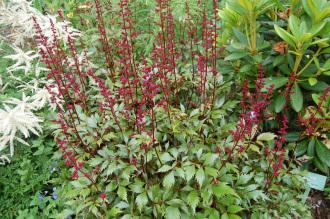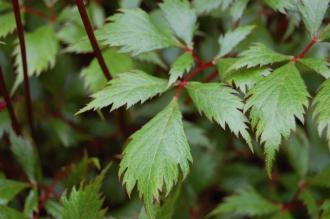
Astilbe japonica ‘Montgomery’ (16/06/2014, Dunvegan Castle, Isle of Skye, Scotland)
Position: Light shade to full shade
Flowering period: Summer
Soil: Moist, well drained
Eventual Height: 60cm
Eventual Spread: 60cm
Hardiness: 4a, 4b, 5a, 5b, 6a, 6b, 7a, 7b, 8a, 8b, 9a, 9b
Family: Saxifragaceae
Astilbe japonica ‘Montgomery’ is a deciduous herbaceous perennial with a clump forming habit. Its dark green leaves are bipinnate and up to 20cm long. Its leaflets are ovate with serrate margins, up to 7cm long and 4cm broad. Its leaves appear bronze in spring. Its dark red flowers appear as terminal panicles.. Its roots are fleshy rhizomes which aids its spread.

Astilbe japonica ‘Montgomery’ Flower Buds (16/06/2014, Dunvegan Castle, Isle of Skye, Scotland)
The species Astilbe japonica, commonly known as Japanese Astilbe, False Spirea or False Goat’s beard, is native to Japan. In its native habitat it grows in damp forests, scrub and ravines.
The etymological root of the binomial name Astilbe is derived from the Greek a meaning ‘without’ and stilbw meaning ‘glitter’. Japonica is derived from the Latin meaning ‘from Japan’.
The landscape architect may find Astilbe japonica ‘Montgomery’ useful as an attractive flowering perennial suitable for damp to wet locations. This plant is not attractive to deer and rabbits.
Ecologically,Astilbe japonica ‘Montgomery’ flowers are attractive to pollinating insects.

Astilbe japonica ‘Montgomery’ Leaf (16/06/2014, Dunvegan Castle, Isle of Skye, Scotland)
Astilbe japonica ‘Montgomery’ prefers moist, humus rich, fertile, well-drained soils. It tolerates most pH of soil. It dislikes dry soils
Astilbe japonica ‘Montgomery’ requires little maintenance. Large clumps may be divided in spring.

